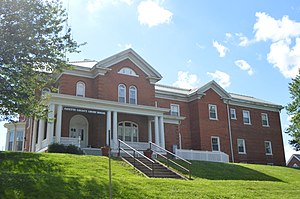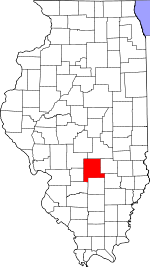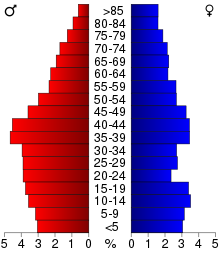Fayette County, Illinois
Fayette County | |
|---|---|
 | |
 Location within the U.S. state of Illinois | |
 Illinois's location within the U.S. | |
| Coordinates: 39°00′N 89°01′W / 39°N 89.02°W | |
| Country | |
| State | |
| Founded | 1821 |
| Named for | Marquis de Lafayette |
| Seat | Vandalia |
| Largest city | Vandalia |
| Area | |
| • Total | 725 sq mi (1,880 km2) |
| • Land | 716 sq mi (1,850 km2) |
| • Water | 8.9 sq mi (23 km2) 1.2% |
| Population (2020) | |
| • Total | 21,488 |
| • Density | 30/sq mi (11/km2) |
| Time zone | UTC−6 (Central) |
| • Summer (DST) | UTC−5 (CDT) |
| Congressional district | 15th |
| Website | www |
Fayette County is a county located in the U.S. state of Illinois. As of the 2020 census, the population was 21,488.[1] Its county seat is Vandalia,[2] the site of the Vandalia State House State Historic Site. Ramsey Lake State Recreation Area is located in the northwestern part of this county.
History
[edit]Fayette County was formed in 1821 out of Bond, Clark, and Crawford counties; according to one source, the county was formed on February 14, 1812.[3] It was named in honor of the Marquis de LaFayette, French hero of the American Revolutionary War.[4][5]
In 1823, Marion County, Illinois was carved out from the southernmost part of Fayette County; this was followed by the creation of Clay, Clinton and Shelby Counties from Fayette County areas.[3] Early Tazewell County also received acreage from Fayette County.[3] The year 1831 saw the creation of Effingham County and the establishment of the modern Fayette County boundaries.[3]
-
Fayette County between the time of its creation and 1823
-
Fayette between 1823 and 1824
-
Fayette between 1824 and 1827
-
Fayette between 1827 and 1831
-
Fayette in 1831, when the creation of Effingham County reduced it to its current size
Geography
[edit]According to the U.S. Census Bureau, the county has a total area of 725 square miles (1,880 km2), of which 716 square miles (1,850 km2) is land and 8.9 square miles (23 km2) (1.2%) is water.[6]
Climate and weather
[edit]| Vandalia, Illinois | ||||||||||||||||||||||||||||||||||||||||||||||||||||||||||||
|---|---|---|---|---|---|---|---|---|---|---|---|---|---|---|---|---|---|---|---|---|---|---|---|---|---|---|---|---|---|---|---|---|---|---|---|---|---|---|---|---|---|---|---|---|---|---|---|---|---|---|---|---|---|---|---|---|---|---|---|---|
| Climate chart (explanation) | ||||||||||||||||||||||||||||||||||||||||||||||||||||||||||||
| ||||||||||||||||||||||||||||||||||||||||||||||||||||||||||||
| ||||||||||||||||||||||||||||||||||||||||||||||||||||||||||||
In recent years, average temperatures in the county seat of Vandalia have ranged from a low of 18 °F (−8 °C) in January to a high of 88 °F (31 °C) in July, although a record low of −21 °F (−29 °C) was recorded in January 1985 and a record high of 104 °F (40 °C) was recorded in July 1980. Average monthly precipitation ranged from 2.41 inches (61 mm) in February to 4.11 inches (104 mm) in May.[7]
Adjacent counties
[edit]- Shelby County - northeast
- Effingham County - east
- Clay County - southeast
- Marion County - south
- Clinton County - southwest
- Bond County - west
- Montgomery County - northwest
Major highways
[edit] Interstate 57
Interstate 57 Interstate 70
Interstate 70 U.S. Route 40
U.S. Route 40 U.S. Route 51
U.S. Route 51 Illinois Route 33
Illinois Route 33 Illinois Route 37
Illinois Route 37 Illinois Route 128
Illinois Route 128 Illinois Route 140
Illinois Route 140 Illinois Route 185
Illinois Route 185
Demographics
[edit]| Census | Pop. | Note | %± |
|---|---|---|---|
| 1830 | 2,704 | — | |
| 1840 | 6,328 | 134.0% | |
| 1850 | 8,075 | 27.6% | |
| 1860 | 11,189 | 38.6% | |
| 1870 | 19,638 | 75.5% | |
| 1880 | 23,241 | 18.3% | |
| 1890 | 23,367 | 0.5% | |
| 1900 | 28,065 | 20.1% | |
| 1910 | 28,075 | 0.0% | |
| 1920 | 26,187 | −6.7% | |
| 1930 | 23,487 | −10.3% | |
| 1940 | 29,159 | 24.1% | |
| 1950 | 24,582 | −15.7% | |
| 1960 | 21,946 | −10.7% | |
| 1970 | 20,752 | −5.4% | |
| 1980 | 22,167 | 6.8% | |
| 1990 | 20,893 | −5.7% | |
| 2000 | 21,802 | 4.4% | |
| 2010 | 22,140 | 1.6% | |
| 2020 | 21,488 | −2.9% | |
| 2023 (est.) | 21,164 | [8] | −1.5% |
| U.S. Decennial Census[9] 1790-1960[10] 1900-1990[11] 1990-2000[12] 2010[13] | |||

As of the 2010 United States Census, there were 22,140 people, 8,311 households, and 5,648 families living in the county.[15] The population density was 30.9 inhabitants per square mile (11.9/km2). There were 9,302 housing units at an average density of 13.0 per square mile (5.0/km2).[6] The racial makeup of the county was 93.7% white, 4.4% black or African American, 0.2% Asian, 0.2% American Indian, 0.4% from other races, and 1.0% from two or more races. Those of Hispanic or Latino origin made up 1.4% of the population.[15] In terms of ancestry, 27.5% were German, 10.5% were English, 9.4% were American, and 9.3% were Irish.[16]
Of the 8,311 households, 31.2% had children under the age of 18 living with them, 53.3% were married couples living together, 9.7% had a female householder with no husband present, 32.0% were non-families, and 27.2% of all households were made up of individuals. The average household size was 2.45 and the average family size was 2.95. The median age was 39.9 years.[15]
The median income for a household in the county was $41,269 and the median income for a family was $51,216. Males had a median income of $38,257 versus $27,188 for females. The per capita income for the county was $21,663. About 10.8% of families and 16.1% of the population were below the poverty line, including 22.6% of those under age 18 and 12.0% of those age 65 or over.[17]
Communities
[edit]Cities
[edit]Villages
[edit]Unincorporated communities
[edit]Townships
[edit]Fayette County is divided into twenty townships:
Politics
[edit]Until the beginning of the twentieth century, Fayette County was rock-ribbed Democratic. It was not won by a Republican until Theodore Roosevelt’s landslide win of 1904. The county voted after that for the winning candidate in every election until 1940, when opposition to Franklin D. Roosevelt’s economic and war policies gave the county to Wendell Willkie. Since then only two Democratic presidential candidates have gained an absolute majority in the county – the more recent of these two, Jimmy Carter in 1976, doing so by a single vote.
| Year | Republican | Democratic | Third party(ies) | |||
|---|---|---|---|---|---|---|
| No. | % | No. | % | No. | % | |
| 2020 | 8,055 | 79.94% | 1,826 | 18.12% | 195 | 1.94% |
| 2016 | 7,372 | 76.86% | 1,819 | 18.97% | 400 | 4.17% |
| 2012 | 5,951 | 66.03% | 2,853 | 31.66% | 208 | 2.31% |
| 2008 | 5,499 | 56.64% | 3,967 | 40.86% | 242 | 2.49% |
| 2004 | 5,880 | 61.58% | 3,571 | 37.40% | 98 | 1.03% |
| 2000 | 5,200 | 55.69% | 3,886 | 41.61% | 252 | 2.70% |
| 1996 | 3,881 | 44.14% | 3,887 | 44.21% | 1,024 | 11.65% |
| 1992 | 3,508 | 34.67% | 4,833 | 47.77% | 1,777 | 17.56% |
| 1988 | 5,452 | 53.88% | 4,632 | 45.78% | 34 | 0.34% |
| 1984 | 6,607 | 63.09% | 3,844 | 36.70% | 22 | 0.21% |
| 1980 | 6,523 | 62.67% | 3,614 | 34.72% | 271 | 2.60% |
| 1976 | 5,059 | 49.33% | 5,128 | 50.00% | 68 | 0.66% |
| 1972 | 6,574 | 61.05% | 4,192 | 38.93% | 2 | 0.02% |
| 1968 | 5,449 | 52.38% | 4,011 | 38.56% | 943 | 9.06% |
| 1964 | 4,492 | 41.64% | 6,295 | 58.36% | 0 | 0.00% |
| 1960 | 6,586 | 57.25% | 4,907 | 42.65% | 11 | 0.10% |
| 1956 | 6,739 | 57.81% | 4,914 | 42.15% | 5 | 0.04% |
| 1952 | 7,028 | 56.96% | 5,299 | 42.95% | 12 | 0.10% |
| 1948 | 5,717 | 49.25% | 5,771 | 49.72% | 120 | 1.03% |
| 1944 | 6,332 | 53.27% | 5,435 | 45.72% | 120 | 1.01% |
| 1940 | 7,486 | 50.19% | 7,286 | 48.85% | 143 | 0.96% |
| 1936 | 6,419 | 48.01% | 6,824 | 51.04% | 128 | 0.96% |
| 1932 | 5,122 | 41.44% | 7,053 | 57.06% | 185 | 1.50% |
| 1928 | 6,545 | 61.65% | 3,998 | 37.66% | 73 | 0.69% |
| 1924 | 5,010 | 48.43% | 4,668 | 45.13% | 666 | 6.44% |
| 1920 | 5,758 | 58.48% | 3,824 | 38.84% | 264 | 2.68% |
| 1916 | 5,316 | 46.55% | 5,669 | 49.65% | 434 | 3.80% |
| 1912 | 1,481 | 24.51% | 2,782 | 46.04% | 1,779 | 29.44% |
| 1908 | 3,261 | 48.67% | 3,193 | 47.66% | 246 | 3.67% |
| 1904 | 3,253 | 51.62% | 2,650 | 42.05% | 399 | 6.33% |
| 1900 | 2,920 | 44.79% | 3,423 | 52.51% | 176 | 2.70% |
| 1896 | 2,769 | 42.46% | 3,627 | 55.61% | 126 | 1.93% |
| 1892 | 1,980 | 36.66% | 2,433 | 45.05% | 988 | 18.29% |
See also
[edit]References
[edit]- United States Census Bureau 2007 TIGER/Line Shapefiles
- United States Board on Geographic Names (GNIS)
- United States National Atlas
- ^ "Fayette County, Illinois". United States Census Bureau. Archived from the original on June 28, 2023. Retrieved November 30, 2023.
- ^ "NACo County Explorer". County Explorer. National Association of Counties. Retrieved November 30, 2023.
- ^ a b c d Hoffman, Esther Halford (1969). Fayette County, Illinois Marriage Index 1821-1874. Decatur, Illinois: Decatur Genealogical Society. pp. i. Retrieved November 30, 2023 – via Internet Archive.
- ^ Keith, Allan H (2002). Historical Stories About Greenville and Bond County, IL. Mattoon, Illinois: self-published. p. 15. LCCN 2007373029. Retrieved November 30, 2023 – via Internet Archive.
- ^ Gannett, Henry (1905). The Origin of Certain Place Names in the United States (2nd ed.). Washington, D.C.: Government Printing Office. p. 124. Retrieved November 30, 2023 – via Internet Archive.
- ^ a b "Population, Housing Units, Area, and Density: 2010 - County". United States Census Bureau. Archived from the original on February 12, 2020. Retrieved July 11, 2015.
- ^ a b "Monthly Averages for Vandalia, Illinois". The Weather Channel. Archived from the original on October 23, 2012. Retrieved January 27, 2011.
- ^ "Annual Estimates of the Resident Population for Counties: April 1, 2020 to July 1, 2023". United States Census Bureau. Retrieved April 2, 2024.
- ^ "U.S. Decennial Census". United States Census Bureau. Archived from the original on July 17, 2022. Retrieved July 5, 2014.
- ^ "Historical Census Browser". University of Virginia Library. Archived from the original on August 11, 2012. Retrieved July 5, 2014.
- ^ "Population of Counties by Decennial Census: 1900 to 1990". United States Census Bureau. Archived from the original on April 24, 2014. Retrieved July 5, 2014.
- ^ "Census 2000 PHC-T-4. Ranking Tables for Counties: 1990 and 2000" (PDF). United States Census Bureau. Archived (PDF) from the original on December 18, 2014. Retrieved July 5, 2014.
- ^ "State & County QuickFacts". United States Census Bureau. Archived from the original on June 6, 2011. Retrieved July 5, 2014.
- ^ Vandalia Correctional Center Archived December 9, 2006, at the Wayback Machine
- ^ a b c "DP-1 Profile of General Population and Housing Characteristics: 2010 Demographic Profile Data". United States Census Bureau. Archived from the original on February 13, 2020. Retrieved July 11, 2015.
- ^ "DP02 SELECTED SOCIAL CHARACTERISTICS IN THE UNITED STATES – 2006-2010 American Community Survey 5-Year Estimates". United States Census Bureau. Archived from the original on February 13, 2020. Retrieved July 11, 2015.
- ^ "DP03 SELECTED ECONOMIC CHARACTERISTICS – 2006-2010 American Community Survey 5-Year Estimates". United States Census Bureau. Archived from the original on February 13, 2020. Retrieved July 11, 2015.
- ^ Leip, David. "Dave Leip's Atlas of U.S. Presidential Elections". uselectionatlas.org. Archived from the original on March 23, 2018. Retrieved April 30, 2018.






